
I confess: I am a makeover junkie. I have seen almost every episode of
Trading Spaces,
What Not to Wear, and
Queer Eye for the Straight Guy. Now before you hand me my penance for my addiction, there’s something I’ve noticed about these makeover shows. These are not your typical shows in which a person is put under the knife to undergo thousands of dollars of unnecessary plastic surgery in order to feel better and in the end finally realize that it really wasn’t worth it. What has moved me to embarrassed weepiness when I watch these shows is seeing a person be
really transformed, not because of new clothes, makeup, a fancy hairdo, perfectly-shaped eyebrows (although that's important), a renovated kitchen, or cool hair product. The transformation happens simply because people—friends and strangers alike—get together to do something for another person so that they could live with more dignity, joy, and peace. Take for instance two of my new favorites:
Extreme Makeover: Home Edition and
Town Haul.
In
Extreme Makeover: Home Edition (not to be confused with Extreme Makeover: plastic surgery massacre), a struggling family is chosen to be given a completely new home, built on their home’s existing lot. A team of carpenters, designers, plumbers, and electricians meet with the family, not to show them designs and plans but just to get to know their story. They play with the kids, look at family photos, hear about their work, learn their hobbies, and listen to their fears for the future. Then they send the family on retreat at a spa or vacation resort to be pampered while the team builds their new home. Throughout the week, local businesses come and donate supplies and services, local artisans create beautiful woodwork, stone paths, and paintings for the new home, and neighbors, classmates, friends, and relatives help paint and hammer, sometimes creating video greetings from far away friends for the family’s homecoming. The big "reveal" is filled with many tears of joy and appreciation from the family and all those who built their home.
In
Town Haul, an entire town commits to rebuilding and renovating the homes, businesses, and lives of some of its own members. In one episode, one local affectionately called “Cowboy Bob” was given a completely new home. Bob and his dog live in the outskirts of town in a small cottage. He lost the use of his legs, does not drive a car, and gets around only by electric scooter. The town decided they wanted Bob to have a home in town so it would be easier for him to get to the grocery store and other places he needs to go. The town banded together to form teams: those handy with carpentry and construction work built the foundation and put up the walls; the teens painted the house; the elders sewed pillows, curtains, and bed linens; the local artisans paved a new driveway using stone carving skills they learned in Italy, the Boy Scouts built a new dog house, the town mechanic put together a new scooter for Bob.
Cowboy Bob came home, and standing along his driveway were people he knew and many more he’d never met. The transformation was evident, not in the walls or the wood, but in the hearts of everyone there. Yes, he had a new home, but more importantly, the town had a new vision of relationship in which lives are changed for the better because people work together to make it happen. In a way, the town itself was renovated and became a new home for everyone who lived there. Really, they didn’t do anything extraordinary. They simply used the skills they had, tried to learn some new ones, gave their time and attention to each other, and shared their stories. By their work and care for each other, they changed Bob’s life, but they also changed their own.
I see the sacred season of Lent in the same way. In our town called Church, we have chosen the Elect to be our focus of attention. We build for them a new home not by relegating the task to a few people (pastor, godparents, or initiation directors), but by engaging the whole town in the work. We each do our part, whether it's praying more fervently, fasting more joyfully, or giving what we have to those in need—nothing extravagant, but all ordinary actions that take on extraordinary power when we all do it together. In the end, the Elect are changed into the Body of Christ not simply because we make them over with new clothes of white or new lighting for their mantles. They are changed because they have seen and heard and known the power of God’s love in us--the power to sacrifice in big and small ways, to love our enemies and forgive those who have hurt us, to share bits of bread and wine and call it a feast, and to put another’s needs before our own.
Lent is our extreme makeover. May the practices we take on during this season not be as short-lived as a Botox injection but transform us in our deepest corners of our selves so that our lives become living signs of Christ, dead and risen.
In this edition of
DSJ Liturgy Notes, you’ll find:
May our lenten spring cleaning bring us to new life!
Diana Macalintal
Associate for Liturgy
FILED UNDER: OPENING ARTICLES
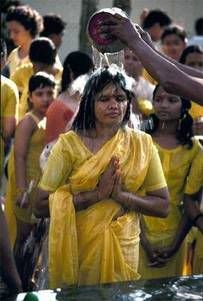 If you coordinate the catechumenate process (Rite of Christian Initiation of Adults) in your parish, you have a place where you can ask questions, get some answers, and share your own stories with others who share your ministry. The Catechumenate Support Group meets every other month and is open for all who have responsibility for initiation of adults and children.
If you coordinate the catechumenate process (Rite of Christian Initiation of Adults) in your parish, you have a place where you can ask questions, get some answers, and share your own stories with others who share your ministry. The Catechumenate Support Group meets every other month and is open for all who have responsibility for initiation of adults and children. I confess: I am a makeover junkie. I have seen almost every episode of Trading Spaces, What Not to Wear, and Queer Eye for the Straight Guy. Now before you hand me my penance for my addiction, there’s something I’ve noticed about these makeover shows. These are not your typical shows in which a person is put under the knife to undergo thousands of dollars of unnecessary plastic surgery in order to feel better and in the end finally realize that it really wasn’t worth it. What has moved me to embarrassed weepiness when I watch these shows is seeing a person be really transformed, not because of new clothes, makeup, a fancy hairdo, perfectly-shaped eyebrows (although that's important), a renovated kitchen, or cool hair product. The transformation happens simply because people—friends and strangers alike—get together to do something for another person so that they could live with more dignity, joy, and peace. Take for instance two of my new favorites: Extreme Makeover: Home Edition and Town Haul.
I confess: I am a makeover junkie. I have seen almost every episode of Trading Spaces, What Not to Wear, and Queer Eye for the Straight Guy. Now before you hand me my penance for my addiction, there’s something I’ve noticed about these makeover shows. These are not your typical shows in which a person is put under the knife to undergo thousands of dollars of unnecessary plastic surgery in order to feel better and in the end finally realize that it really wasn’t worth it. What has moved me to embarrassed weepiness when I watch these shows is seeing a person be really transformed, not because of new clothes, makeup, a fancy hairdo, perfectly-shaped eyebrows (although that's important), a renovated kitchen, or cool hair product. The transformation happens simply because people—friends and strangers alike—get together to do something for another person so that they could live with more dignity, joy, and peace. Take for instance two of my new favorites: Extreme Makeover: Home Edition and Town Haul.
 “Remember, man, you are dust and to dust you will return” (Gn 3:19). This reminder is given to those who are signed with ashes at the beginning of the Lenten season. This ancient action of wearing ashes has traditionally signified lamentation and repentance (see 2 Sam 13:19, Esth 4:1, Job 42:6, 1 Macc 3:47, 4:39, Lam 2:10, Mt 11:21). Still today, this symbol speaks dramatically of both the morbid reality of being human and the joyful promise made to all God’s own.
“Remember, man, you are dust and to dust you will return” (Gn 3:19). This reminder is given to those who are signed with ashes at the beginning of the Lenten season. This ancient action of wearing ashes has traditionally signified lamentation and repentance (see 2 Sam 13:19, Esth 4:1, Job 42:6, 1 Macc 3:47, 4:39, Lam 2:10, Mt 11:21). Still today, this symbol speaks dramatically of both the morbid reality of being human and the joyful promise made to all God’s own.

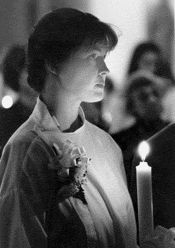 Contrary to our typical desert-dry liturgical image of the season, Lent coincides with spring when the daffodils planted before the winter frost begin to bloom. In some places, spring is the most turbulent time of the year. Winter snows persist and spring storms attack the tender buds of young plants and bare trees. In this hostile environment, calves, lambs and other newborns fight to make it to the gentler days of early summer.
Contrary to our typical desert-dry liturgical image of the season, Lent coincides with spring when the daffodils planted before the winter frost begin to bloom. In some places, spring is the most turbulent time of the year. Winter snows persist and spring storms attack the tender buds of young plants and bare trees. In this hostile environment, calves, lambs and other newborns fight to make it to the gentler days of early summer.
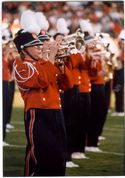 For this reason, the sound of Lent cannot be sad, anemic or depressed. We are reminded from the start of the season, “When you fast, do not look gloomy like the hypocrites” (Mt 6:16). The soundtrack to this great drama must be intense. We begin Ash Wednesday with “Blow the trumpet in Zion!” (Jl 2:15), a proclamation to gather the nations. But don’t confuse intense with bombastic or loud. Silence—penetrating stillness that cuts through pretension—is our most fundamental Lenten sound.
For this reason, the sound of Lent cannot be sad, anemic or depressed. We are reminded from the start of the season, “When you fast, do not look gloomy like the hypocrites” (Mt 6:16). The soundtrack to this great drama must be intense. We begin Ash Wednesday with “Blow the trumpet in Zion!” (Jl 2:15), a proclamation to gather the nations. But don’t confuse intense with bombastic or loud. Silence—penetrating stillness that cuts through pretension—is our most fundamental Lenten sound.
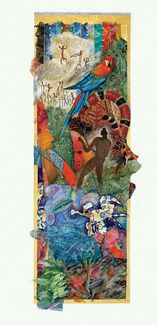 As some of you know, I go to school at Saint John's University in Collegeville, Minnesota, during the summer months. The Benedictines who live, work, and teach there have always been committed to the arts and especially to exploring how art deepens our relationship with God, the Master Artist.
As some of you know, I go to school at Saint John's University in Collegeville, Minnesota, during the summer months. The Benedictines who live, work, and teach there have always been committed to the arts and especially to exploring how art deepens our relationship with God, the Master Artist. 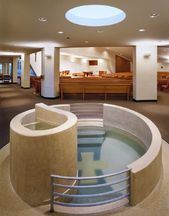
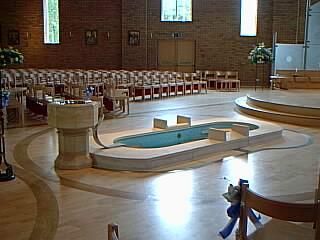
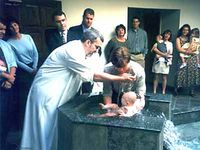 What the faithful should be hungering and thirsting for is not the symbol of their baptism but rather a world in which the faithful living out of that baptism is evident. For the catechumens, their hunger for baptism may even be heightened when there are full fonts of water, just as a person who fasts is more aware of their hunger when food is placed before them.
What the faithful should be hungering and thirsting for is not the symbol of their baptism but rather a world in which the faithful living out of that baptism is evident. For the catechumens, their hunger for baptism may even be heightened when there are full fonts of water, just as a person who fasts is more aware of their hunger when food is placed before them.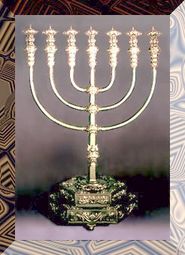 Dianne Portnoy conducted this session on the
Dianne Portnoy conducted this session on the 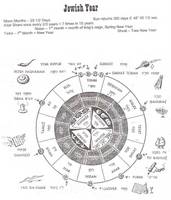
 Below is the final schedule for Rite of Election 2005. Seating charts for each evening will be available next week. If you have any questions, contact Diana Macalintal at
Below is the final schedule for Rite of Election 2005. Seating charts for each evening will be available next week. If you have any questions, contact Diana Macalintal at